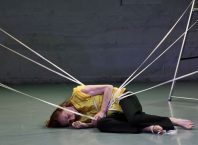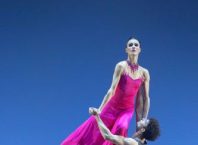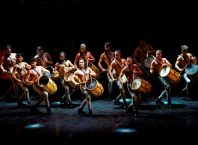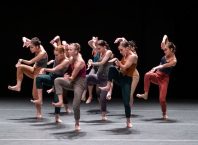Taking its name from the polar night in Finland that can last for over 24 hours, Ohad Naharin’s Kaamos explores the cold and dark regions of the soul. Five dancers sparsely clad in exotically colored deconstructed kilts stand poised in the silent semi-darkness, blue lights glowing behind them from the back of the stage. There is an almost imperceptible movement in their chest and shoulders as they breathe. The movement appears to emerge from a place deep within their bodies, growing larger as the music begins. Dancing in unison, one dancer separates from the group and walks away, faltering, her steps awkward and halting. As the light increases, five additional dancers can be seen sitting in a row at the back of the stage, immobile, waiting and watching like silent oracles or judges.
Kaamos was originally created for the Netherlands Dance Theater in 1995. Naharin, with his penchant for continually changing and remixing choreography, incorporated the choreography into the full length Z\na, performed at the time in Israel by the Batsheva Dance Company. Bringing Kaamos back to the stage after such a long interval, Naharin set the work on his junior company, the Batsheva Ensemble. Retaining the original costumes by Rakefet Levy and music composed by Ivri Lider, a successful Israeli musician who was only twenty at the time he composed the score.
The dancers have earphones through which they hear a different soundtrack – in this case, selections from Prince and Tom Waits. This alternative soundtrack forms the rhythmic structure for their movements, rather than the score heard by the audience. A sense of alienation is created by the slight dissonance between the dancers’ movements and the score. This is a technique Naharin has employed in several of his dances, among them: FURO, Max, and Seder. Comparing music to an oriental rug, Naharin says, “It creates an atmosphere…it is not illustrative.”
Avoiding one to one correspondences and coherent narratives is a trademark of Naharin’s work and Kaamos is no exception. Fragmented narratives, both visual and verbal, evoke a sense of difficulty and isolation. The dancers freeze and convulse into movement that then flows into a dance sequence, a recurring pattern of distorted virtuosity. One dancer lies on her stomach facing the audience, and recites a text into a microphone: “For the record, we tried…a void, a heart.” Like the movement, it offers no explanations, but rather another point of origin for a journey. Naharin created the text while in Europe, having set himself a task of writing for an hour each day. He chose to write in English rather than his native Hebrew, he says, “to create a sense of distance that I wanted to have in this work.”
Towards the end of the piece a young man in a Scottish kilt enters playing bagpipes, walks across the stage and exits, colorful, noisy, and utterly incomprehensible. The five seated dancers rise and occupy the center of the stage, while the first five lay stomachs down facing the audience, faces illuminated. The dancers repeat the first movements as the lights dim, the strange dream-like quality of the work enhanced as it ends at its point of origin.
Kaamos is presented as the central part of an evening which begins with Naharin’s duet Passomezzo (1988) and concludes with Sharon Eyal’s love (2003). The evening as a whole revolves around the intricacy of relationships. Kaamos and Passomezzo offering a more intimate, individual perspective while love has a more tribal quality, situating the individual and desire in relation to mass culture.
Image Credit: Gadi Dagon
Performances:
Thursday, July 2 at 21:00 and Friday, July 3 at 22:00
Suzanne Dellal Centre, 8 Yehieli Street, Neve Tzedek, Tel Aviv
Tickets: 03-5105656
www.suzannedellal.org.il





